How to care for blackberries in spring and summer in the country: basic care measures
The weather has become truly spring, you finally ended up at the dacha, and first decided to ask what needs to be done in the spring in your berry, in which, in addition to grapes, gooseberry, currants and raspberries, the blackberry also grows.
Below you will find information on how to properly care for garden blackberries in the spring to get a good harvest.
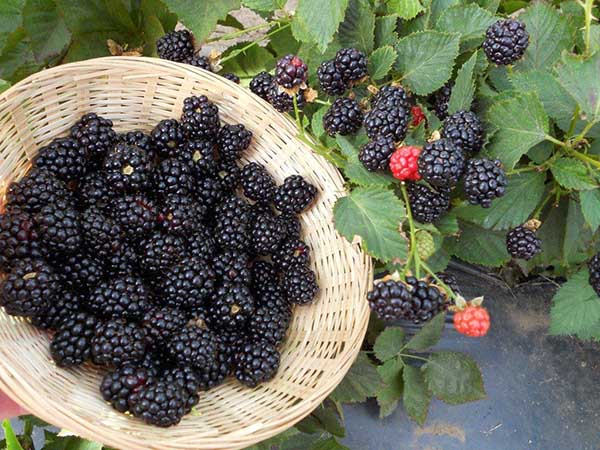
Content
How to care for blackberries in spring: basic care activities
By the way! In general, caring for a blackberry is not much different from spring care for raspberries, but there are some nuances.
Taking shelter after winter
So, naturally, the first thing you need to do is open up the blackberry bushes, taking off their winter shelter in time.
But when is it better to do it?
As a rule, the shelter is removed after warm weather is established, the soil thaws and warms up enough, and most importantly, sap flow begins in the shoots, i.e. only in the second half of April and early May (relevant for the Middle Lane).
Important! You should not rush to open the bushes. If you remove the shelter too early - until the root system wakes up, then, since the ground is cold, the consequences will be sad ...
Video: when to take a shelter from a blackberry
Pruning
Perhaps one of the main success factors in growing blackberries is their regular and competent pruning, which, as a rule, is carried out after harvest (in the fall).
However, if for some reason you could not, forgot or did not know that it is better to prune blackberries in the fall, then, of course, this must be done in the spring.
Note! The site already has a detailed article about how to properly prune blackberries in spring.
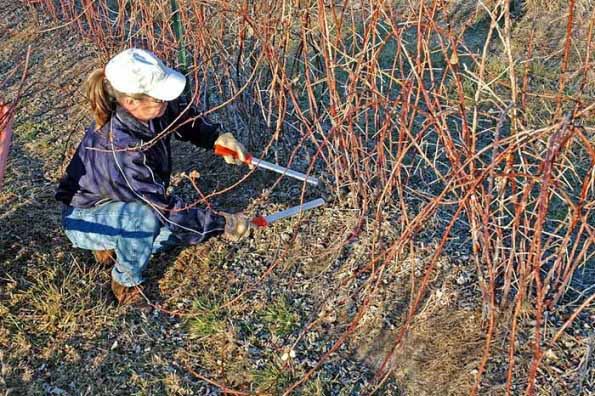
In general, in early spring only sanitary pruning (the shoots that have frozen over the winter are removed completely or cut to healthy wood).
It is also recommended to pinch (pinch) the tops of the shoots, which is aimed at awakening the lateral buds = more abundant fruiting.
In erect varieties, shoots are left 1.5-2 meters, in creeping ones - up to 2-3 meters.
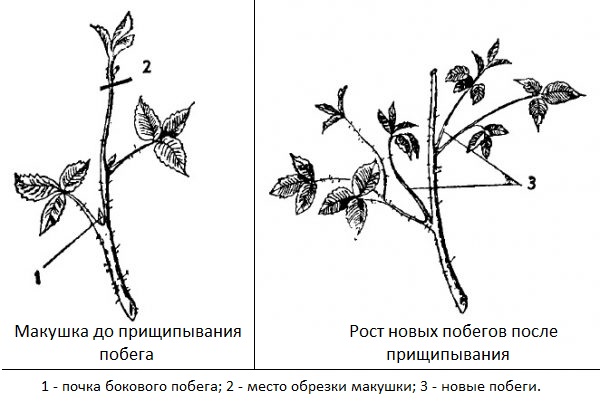
By the way! If you live in the South of Russia or your climate is mild, then in the spring you may find that the blackberry bushes will stand with leaves, unless the lower ones dry out. In this case, it is better to cut off all the old leaves yourself so that they do not interfere with the growth of the young.
Garter shoots
Immediately after the spring pruning of the blackberry, they begin to lift it onto the trellis and further garter the shoots.
Next, we will consider several ways to tie up blackberry bushes.
Note! If creeping varieties can be placed as you like, because they bend well, but with the upright ones, everything is not so simple: they, at least, cannot be “twisted” around the trellis wire.
Of course, it is not at all necessary to focus on the methods that will be named and described below. The main thing is to distribute the shoots as evenly as possible over the trellis (so that there is no thickening), so that the bush is well lit and ventilated, and it is convenient for you to harvest.
Important! The trellis must be strong enough, because the shoots are very heavy.
Video: garter a blackberry on a trellis
Important! Whichever method of garter the blackberry you choose, under no circumstances tie up all the shoots in a bunch! This is a guaranteed loss of yield and the occurrence of diseases!
So, there are several main ways to tie a blackberry:

- The easiest way - unilateral tilt... Last year's shoots that will bear fruit this year are tied to one side, for example, to the right or left. And new shoots formed this year are tied up in the other direction, for example, to the left or to the right.
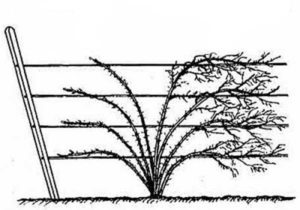
Or you can do this (by the type of rope method):

Generally speaking, the essence of all the following methods is to start young shoots in the middlethat will appear in the summer, and fruiting last year's shoots - initially placed on the sides (right and left).
- Fanny way. Young shoots that form a little later are placed straight up. Last year's, which will bear fruit this year, are tied up in different directions (part to the right, part to the left).
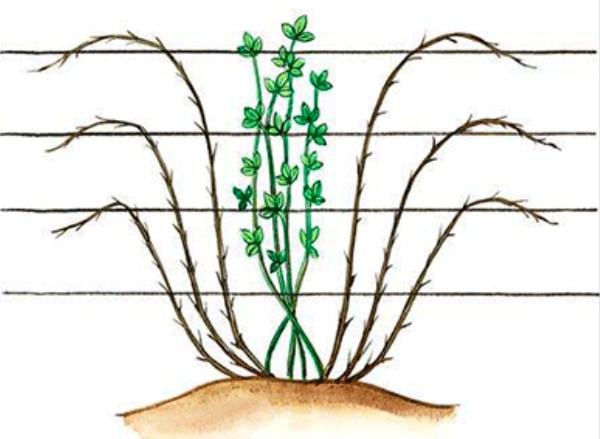
- Cable way. In general, the method is similar to the previous one, except that in this case, the shoots, as it were, "twine" trellises around the wire.
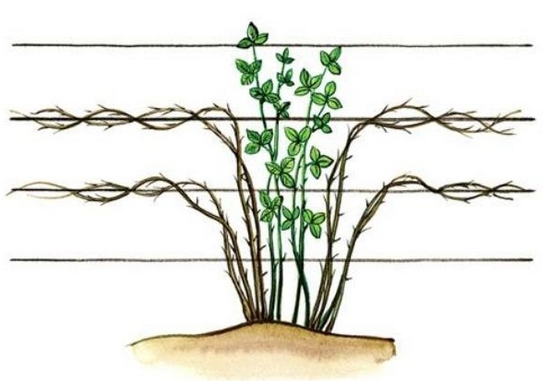
- Wave garter... Fruiting shoots are placed on the lower and middle rows, while they are arranged as if in "waves". And new shoots are on the top row of the trellis wire in different directions.
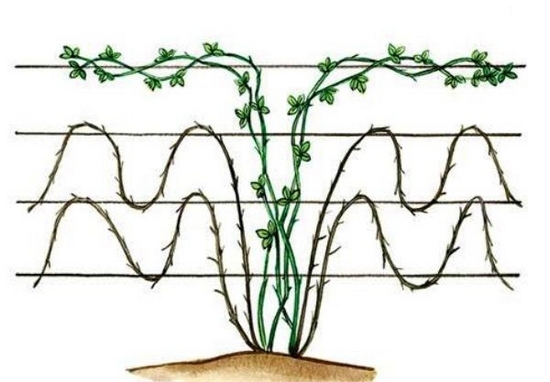
- Another very convenient method. All fruiting shoots are placed on the upper wires on the right and left (on different sides). Young shoots are tied up along the lower wire parallel to the ground.
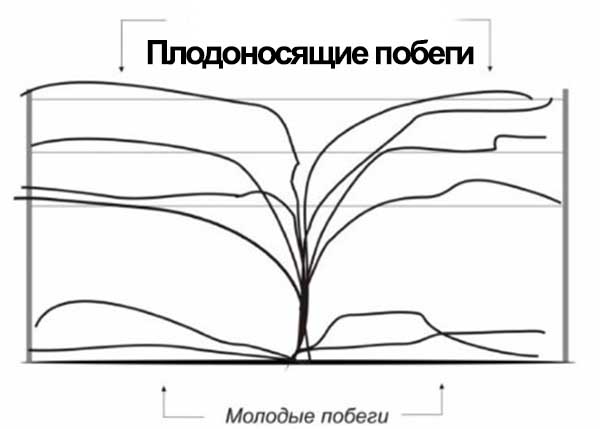
We repeat again! Choose a garter method based on what variety you have. If the variety is creeping, then there will definitely not be any problems with placement and bending, but upright varieties can hardly be fixed like that.
Watering, loosening and mulching
As a rule, the soil is still wet in spring, so berry bushes do not need any additional watering. Another thing is in the summer, before flowering and during fruiting (but before the ripening and coloring of the berries), when the blackberries must be fully provided with nutritious moisture.
However, watering should be approached with restraint (water in moderation, not often, but abundantly). The fact is that blackberries do not tolerate waterlogging, due to which the suction functions of its roots are disrupted and their dying off occurs, the period of growth of shoots is lengthened, their (shoots) maturation is delayed, which leads to a decrease in winter hardiness, in short, has a negative effect on the crop yield.
After each watering, so as not to form an earthen crust, it is advisable to carry out shallow loosening (no deeper than 5 cm) in order to improve the access of air and nutrient moisture to the roots.
You also need to follow the education weeds and conduct regular weeding.
By the way! If you grind planting, the need for loosening and weeding will disappear, and it will be possible to water less often, because the mulch will retain moisture well.
Indeed, mulching is a very effective agricultural technique.
As mulch, you can use any organic matter (humus, compost), peat, sawdust, mown grass, straw, hay.
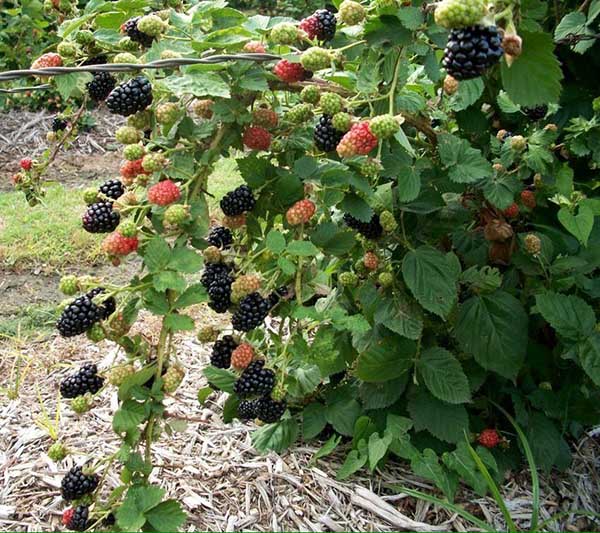
Top dressing
After planting, in the first 2-3 years, if you have carefully filled the planting hole, then no additional fertilizer will be required. But further, in order for the blackberry to be fully provided with the necessary nutrition for active growth and development of shoots (abundant fruiting), you will have to feed it.
The standard scheme for feeding blackberries in spring and summer is as follows:
- in the spring after pruning and garter (for building shoots and leaves) - make nitrogen fertilizers (mineral -urea, ammonium nitrate, organic - various infusions, for example, horse manure or mullein, bird droppings);
You can also mulch the tree trunk circle with nutritious organic matter - humus or compost.
- before flowering (for filling large berries) - potash fertilizers (potassium sulfate, wood ash);
- after flowering and at the beginning of fruiting, potash fertilizers are again applied;
Advice! If you do not want to bother, then in May you can simply add a complex fertilizer (marked "Spring" or "Spring-Summer") or a special one for berry bushes.

- after harvest (for setting flower buds and successful wintering) - phosphoric-potassium fertilizers (for example, potassium sulfate + superphosphate, just potassium monophosphate, any other fertilizer marked "Autumn").
By the way! Blackberries are quite susceptible to chlorosis, so if you see that their leaves have turned yellow, while the veins remain green, then be sure to feed with iron (ferrous sulfate).
Video: feeding blackberries in spring in May - 3 ways
Treatment against diseases and pests
Unlike raspberries, most modern blackberry varieties have a fairly high level of resistance to diseases and pests, therefore, as a rule, blackberries do not even need preventive treatments against diseases and pests.
But in general, diseases and pests in blackberries and raspberries are the same, and hence the measures of protection and control the same.
Advice! Therefore, you may be useful to our material about when and how to treat raspberries in the spring from diseases and pests.

What other activities for the care and cultivation of blackberries can be carried out in the spring
Reproduction
Spring - the ideal time for planting already rooted cuttings (root and stem) and young blackberry seedlings in a permanent place.Also at this time, root suckers and cuttings are planted, propagateddividing the bush.
Important! More about methods of breeding blackberries read in this article.
Planting new seedlings and replanting previously planted
Of course, in the spring you can expand your berry fields by purchasing and planting new seedlings.
You can also transplant the bushes to another place if, for example, it turned out to be unsuccessful (too shady).

Video: transplanting blackberries in spring
Thus, caring for blackberries in spring is no more difficult than caring for raspberries... If you do everything in a timely manner and correctly, then the garden culture will quickly grow and at the end of summer you will be able to harvest a rich harvest of tasty and large berries.
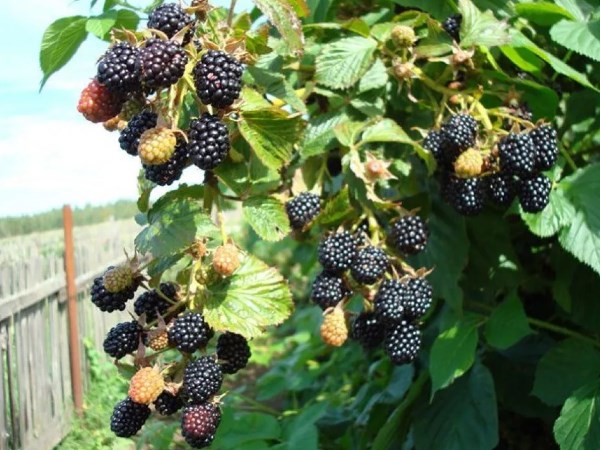


Hello, thanks for the article. I do not cover the bunches of blackberries for the winter, the most important thing is that the bushes are healthy, and not in the wind.